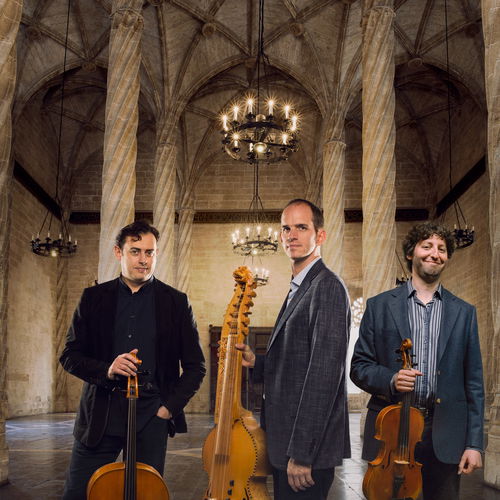Forgotten treasures of Haydn
Details
Valencia Baryton Project full profile / String Trio / 3 musicians
Other players: Brett Walfish, Ismar Gomes
Full program notes
Franz Joseph Haydn - Baryton Trio n 72 in D Major
Steve Zink - The River
Franz Joseph Haydn - Trio n 26 in G major
John Pickup - Prelude 1
Franz Joseph Haydn - Trio n 57 in A major
The Valencia Baryton Project aims to bring to life the nearly forgotten world of the baryton - a rare instrument from the baroque and classical era that is comprised of 16 strings, played both with the bow and plucked like a harp, often at the same time.
In this program we will trace the development in the works of Haydn in the ‘classical’ baryton and investigate the unique and diverse role the instrument played in connecting the baroque and early classical era to the edge of the late classical.
In our program, you can trace the evolution of Haydn’s writing for the baryton. The first 25% of his baryton trio compositions include virtually no back string writing as the instrument was new to Haydn and he wasn’t really sure how to treat these extra strings and so simply let them vibrate sympathetically. The prince was not of much help either as he was learning the baryton at the same time and was only pushed as far as Haydn’s writing would encourage him to go. Haydn was also limited in that in the initial baryton trios, he couldn’t write past his master’s skill level. In this regard, trio number 26 features no back strings, but by trio 70 the back strings feature prominently. However, towards the later trios, Haydn strayed from writing for the additional strings as his tonal centers and harmonic language became more advanced and did not want to be restrained to a certain key. He was also able to write more involved baryton parts as his works were then being performed by other baryton virtuosos from the court and its periphery. We know from the time that whether or not the parts were written, a small amount of ornamental back string improvisation was the norm.
We feel that it is very important to make the baryton relevant to today's musical world so beyond Haydn, the Valencia Baryton Project also will reference and perform a few contemporary works by Steve Zink and John Pickup which were commissioned especially for the trio. With these works, we can see where the contemporary world has picked up where the classical world left off and the use and direction that the soundscapes of the baryton can provide.
Steve Zink (1978), a Canadian composer working both in the film industry as well as the classical music scene, composed “The River” for the Valencia Baryton Project in 2020. The piece depicts the inevitable flow and passage of time and how, even with meandering routes, invariably carries us to a destination. His use of ostinato back string pulses is especially interesting in the thematic material.
"Prelude 1” was composed in 2021 by John Pickup, a film and television composer and talented jazz pianist based in London. After have worked with Matthew Baker since 1999 in their acclaimed jazz duo JPMB, John expressed a keen interest in composing for the baryton. Using the back strings in conjuction with the melody, this work intends to revive the baroque sounds of the instrument but in a modern context.
Historical context
Haydn’s 126 baryton trios, composed during his time as Vice Kapellmeister and Kapellmeister for the Prince Esterhazy number more than either his works for string quartet or his symphonies, and for good reason.
Haydn’s patron, the Prince Esterhazy, was enchanted by the baryton, which was at the time considered one of the most aristocratic instruments. A strange instrument that was all the rage with nobility, the baryton boasted both strings that were played with the bow on the front and strings on the back that were plucked. Although he had likely had a passing familiarity with the baryton through his mother’s employer, the Count Harrach, Haydn himself knew very little about this strange cross between a lirone and a viol da gamba. However, with his appointment as Kapellmeister in 1761, Haydn was required by contract to write exclusively for the Prince and to his musical desires.
In 1765, the Prince sent Haydn a letter of rebuke purportedly for certain failings of keeping his writing and directing up to standards and, as one account has it, for a misbehaving court musician. An anecdote has a musician nearly burning down a cottage and on the palace grounds and subsequently Haydn was severely reprimanded in a letter written by the prince, and at the end of this letter he was encouraged to apply himself to his job with more diligence, and that this new work ethic should include a number of compositions for the baryton.
The trios which he would go on to write would provide Haydn with the proving grounds for his string writing for his symphonic masterpieces. However, Haydn viewed these trios as a frustrating but perplexing puzzle that would keep him on his toes. With all three instruments in a very similar range and with the baryton looking backwards to the earlier sounds while the cello and viola sat quite comfortably in the classical era, combining these instruments to create true works of art is something that only Haydn could do.
Although he had no lack of competition for baryton trio writing during his time at court in the form of composers whose names today are nearly forgotten such as Lidl, Burgksteiner, Neumann, and Tomasini, only Haydn was able to provide the prince with works that could treat this hypnotic instrument with the craft that it deserved.
Videos from this ensemble

 Continue with Facebook
Continue with Facebook
 Continue with Google
Continue with Google
 Continue with Apple
Continue with Apple



